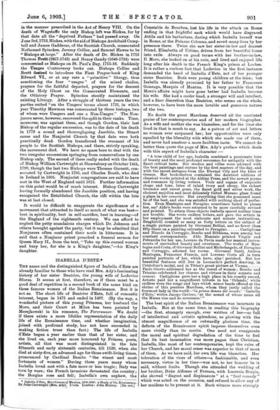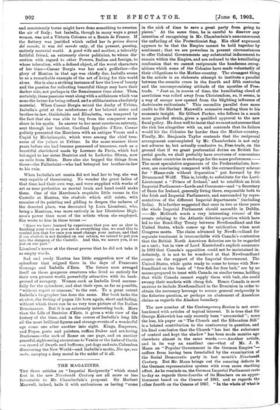ISABELLA D'ESTE.*
THE name and the distinguished figure of Isabella d'Este are already familiar to those who have read Mrs. Ady's fascinating history of her sister Beatrice, the young wife of Lodovico Sforza. It seems at first, therefore, as if there must be a good deal of repetition in a second book of the same kind on these famous women of the Italian Renaissance. But it is not so. The short life of Beatrice d'Este, full of romantic interest, began in 1475 and ended in 1497. (By the way, a wonderful picture of this young Princess, her husband the Moro, and their Court at Milan has been painted by Merejkowski in his romance, The Forerunner. We doubt if there exists a more lifelike representation of the daily life of the Renaissance time, and whether imagination, joined with profound study, has not here succeeded in making fiction truer than fact.) The life of Isabella d'Este began a year earlier than that of her sister, and she lived on, each year more honoured by Princes, poets, artists, all that was most distinguished in the late fifteenth and early sixteenth centuries, till 1539, when she died at sixty-five, an advanced age for those swift-living times, pronounced by Cardinal Bembo " the wisest and most fortunate of women." During those years many whom Isabella loved met with a fate more or less tragic; Italy was torn by wars ; the French invasions devastated the country ; the Borgias rose and fell; Isabella's own nephew, the
• Isabella d'Este, Marchioness of Mantua, 1474-1639: a Study of the Renaissance. By Julia Cartwright (Mrs. Ady). 2 vols. London : John Murray. [25e. net.]
Constable de Bourbon, lost his life in the attack on Rome ending in that frightful sack which would have disgraced Attila and his barbarians, during which Isabella herself was in Rome, at the Palazzo Colonna, and saved many lives by her presence there. Twice she saw her sister-in-law and dearest friend, Elisabetta of Urbino, driven from her beautiful borne into exile. Always on good terms with her brother-in-law, Il Moro, she looked on at his ruin, and lived and enjoyed life long after his death in the French King's prison at Loches. It is rather a curious fact that Lodovico in the first instance demanded the hand of Isabella d'Este, not of her younger sister Beatrice. Both were young children at the time ; but Isabella was already promised by her father to Francesco
Gonzaga, Marquis of Mantua. It is very possible that the Moro's affairs might have gone better had Isabella become his wife. She had a cooler head, a stronger will and intellect,
and a finer discretion than Beatrice, who seems on the whole, however, to have been the more lovable and generous nature of the two.
No doubt the great Marchesa deserved all the unstinted praise of her contemporaries and of her modern biographer. As a wife and mother she was blameless, and for the time she lived in that is much to say. As a patron of art and letters
no woman ever surpassed her; her opportunities were only equalled by the liberality with which she made use of them, and never had amateur a more faultless taste. We cannot do- better than quote the page of Mrs. Ady's preface which deals with this aspect of Isabella's character :— " A true child of her age, Isabella combined a passionate love of beauty and the most profound reverence for antiquity with the finest critical taste. Her studios and villas were adorned with the best paintings and statues by the first masters of the day, and. with the rarest antiques from the Eternal City and the Isles of Greece. Her book-shelves contained the daintiest editions of classical works printed at the Aldine Press, and the newest poems. and romances by living writers. Viols and organs of exquisite shape and tone, lutes of inlaid ivory and ebony, the richest brocades and rarest gems, the finest gold and silver work, the choicest majolica and most delicately tinted Murano glass found a place in her camerini. But everything that she possessed must be of the best, and she was satisfied with nothing short of perfec- tion. Even Mantegna and Perugino sometimes failed to please her, Eine Aldo's books were returned to be more carefully revised and printed. To attain these objects Isabella spared neither time nor trouble. She wrote endless letters, and gave the artists in her employment the most elaborate and minute instructions. Braghirolli counted as many as forty letters on the subject ot a single picture painted by Giovanni Bellini, and no fewer than fifty-three on a painting entrusted to Perugino Castiglione and Niccolo da Correggio, Bembo and Bibbiena, were among her constant correspondents. Aldo Manuzio printed Virgils and Petrarchs for her use, Lorenzo da Pavia made her musical instru- ments of unrivalled beauty and sweetness. The works of Man- tegna and Costa, of Giovanni Bellini and Michelangelo, of Perugia°. and Correggio, adorned her rooms. Giovanni Santi, Andrea Mantegna, Francesco Francia, and Lorenzo Costa all in turn painted portraits of her, which have, alas ! perished. But her
beautiful features still live in Leonardo's perfect drawing, in
Cristoforo's medal, and in Titian's great picture at Vienna Paolo Giovio addressed her as the rarest of women ; Bembo and Trissino celebrated her charms and virtues in their sonnets and cansoni. Castiglione gave her a high place in his courtly record,. Ariosto paid her a magnificent tribute in his ' Orlando,' while endless were the songs and lays which minor bards offered at the shrine of this peerless Marchesa, whom they justly called the foremost lady in the world—' la prima donna del mondo.' Isabella d'Este,' writes Jacopo Caviceo, ' at the sound of whose name all the Muses rise and do reverence.' "
The best spirit of the Italian Renaissance was incarnate in Isabella. But at the same time, in reading this biography —the first, strangely enough, ever written of her—so full of intellectual and artistic splendour, so glowing with the utmost magnificence of an outwardly glorious time, the defects of the Renaissance spirit impress themselves even more vividly than its merits. One need not exaggerate the moral and spiritual degradation of the time to feel that its best incarnation was more pagan than Christian. Isabella, like most of her contemporaries, kept the rules of her Church, and her moral sense was superior to that of most of them. As we have said, her own life was blameless. Her toleration of the vices of others—a fashionable, and even necessary, virtue in her time—was not, to her honour be it said, without limits. Though she attended the wedding of her brother, Duke Alfonso of Ferrara, with Lucrezia Borgia, she showed " disgust and displeasure " at a " foul comedy " which was acted on the occasion, and refused to allow any of her maidens to be present at it. Such witness more strongly and consistently borne might have done something to sweeten the air of Italy ; but Isabella., though in many ways a great woman, was not a Vittoria Colonna or a Renee de France. If the flattery was justified which called her la prima donna del mondo, it was del month, only, of the present, passing, entirely material world. A good wife and mother, a tolerably faithful friend, an extremely clever politician, to whose dis- cretion with regard to other Powers, Italian and foreign, to whose toleration, with a defined object, of the worst characters of her time—Caesar Borgia was her son's godfather—the glory of Mantua in that age was chiefly due, Isabella seems to us a remarkable example of the art of living for this world alone. She is also a striking instance of how the love of beauty and the passion for collecting beautiful things may have their darker side, not perhaps in the Renaissance time alone. Then, certainly, these passions went along with a selfishness which was none the better for being refined, and a utilitarianism absolutely material. When Caesar Borgia seized the duchy of Urbino, Isabella's grief at the misfortunes of her beloved sister and brother-in-law, Guidobaldo and Elisabetta, was tempered by the fact that she was able to beg from the conqueror some share in his spoils. In answer to her most courteous entreaty, sent through her brother, Cardinal Ippolito d'Este, Caesar politely presented the Marchesa with an antique Venus and a Cupid by Michelangelo, which were among the chief trea- sures of the palace at Urbino. In the same manner three years before she had become possessed of treasures, such as a beautiful clavichord made by Lorenzo da Pavia, which bad belonged to her sister Beatrice and to Lodovico Sforza, now an exile from Milan. Here also she begged the things from those—the Pallavicini—who had betrayed her brother-in-law to his ruin.
When Isabella's art mania did not lead her to beg, she was very capable of threatening. No wonder the great ladies of that time had their own way, and were supplied with works of art as near perfection as mortal brain and hand could make them. One of the Marchesa's exquisite little rooms in the .Castello at Mantua, the studiolo which still exists, with remains of its painting and gilding to deepen the sadness of the deserted place, was decorated by Luca Liombeni, who, being a Mantuan, was more entirely in her Illustrious High- ness's power than most of the artists whom she employed. She wrote to him in these terms :- "Since we have learned by experience that you are as slow in finishing your work as you are in everything else, we send this to remind you that for once you must change your nature, and that if our studiolo is not finished on our return, we intend to put you into the dungeon of the Castello. And this, we assure you, is no jest on our part."
Liombeni's terror at the threat proves that he did not take it as empty words.
Sad and reedy Mantua has little suggestion now of the splendour that reigned there in the days of Francesco Gonzaga and Isabella d'Este. The future soon avenged itself on those gorgeous creatures who lived so entirely for their own present world, powerfully attractive with its back- ground of savagery. Women such as Isabella lived success- fully for the splendour, and shut their eyes, as far as possible, " without regret or remorse," to the rest. To a great extent Isabella's biographer has done the same. Her book lacks the sh tdow, the feeling of pagan life born again, short and fading, without which there can be no very true picture of the Italian Renaissance. But it is an extremely interesting book. More than the Life of Beatrice d'Este, it gives a wide view of the history of the time, and in the course of Isabella's long life all the most brilliant figures and strange events of a wonderful age come one after another into sight. Kings, Emperors, and Popes, poets and painters, ruffian Dukes and art-loving Duchesses—the sack of Rome on one page, and on another peaceful, sight-seeing excursions to Venice or the Lake of Garda —a crowd of dwarfs and buffoons, pet dogs andcats, Columbus discovering the New World—and Isabella's motto, Nec ape, nec metu, carrying a deep moral in the midst of it all.











































 Previous page
Previous page